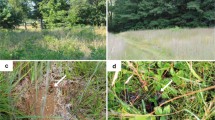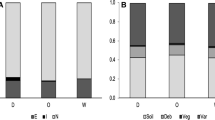Abstract
The quantification of ant nest densities is a useful but challenging task given the group’s high abundance and diversity of nesting sites. We present a new application of a distance-sampling method which follows standard distance analytical procedures, but introduces a sampling innovation that is particularly useful for ants; instead of having an observer look for ants we let ants find a bait station and measure the distances covered between nest and station. We test this method by estimating the density of epigaeic ant nests in an Amazon tropical forest site near Manaus, Brazil. We distributed 220 baits of canned sardine mixed with cassava flour among 10, 210-m long transects in old-growth upland forest. Forty-five minutes after baiting, we followed the ants’ trails and measured the linear distance between the bait and each nest’s entrance. We then used the freely available program DISTANCE to estimate the number of nests per unit area while accounting for the effect of distance on the probability that a colony will find a bait. There were found 38 species nesting in 287 different colonies, with an estimated 2.66 nests/m2. This estimate fell within the 95 % confidence bounds of nest density predicted for a similar number of species based on a literature survey of ant species richness and nest density. Our sampling solution, however, takes less than 30 % of the time used by conventional sampling approaches for a similar area, with the advantage that it produces not only a point estimate but also a quantification of uncertainty about density.



Similar content being viewed by others
References
Baccaro F.B., de Souza J.L.P., Franklin E., Landeiro V.L. and Magnusson W.E. 2012. Limited effects of dominant ants on assemblage species richness in three Amazon forests. Ecol. Entomol. 37: 1–12
Bernadou A., Espadaler X., dos-Reis V. and Fourcassié V. 2011. Effect of substrate roughness on load selection in the seed-harvester ant Messor barbarus L. (Hymenoptera, Formicidae). Behav. Ecol. Sociobiol. 65: 1763–1771
Breton J.L., Jourdan H., Chazeau J., Orivel J. and Dejean A. 2005. Niche opportunity and ant invasion: the case of Wasmannia auropunctata in a New Caledonian rain forest. J. Trop. Ecol. 21: 93–98
Borkin M., Summers W. and Thomas L. 2012. Surveying abundance and stand type associations of Formica aquilonia and F. lugubris (Hymenoptera: Formicidae) nest mounds over an extensive area: Trialing a novel method. Eur. J. Entomol. 109: 47–53
Buckland S.T., Anderson D.R., Burnham K.P. and Laake J.L. 1993. Distance Sampling: Estimation of Biological Populations. Chapman and Hall, New York
Buckland S.T., Anderson D.R., Burnham K.P., Laake J.L., Borchers D.L. and Thomas L. 2001. Introduction to Distance Sampling: Estimating Abundance of Biological Populations. Oxford University Press, Oxford
Buckland S.T., Anderson D.R., Burnham K.P., Laake J.L., Borchers D.L. and Thomas L. 2004. Advanced Distance Sampling: Estimating abundance of biological populations. Oxford University Press, Oxford
Byrne M.M. 1994. Ecology of twig-dwelling ants in a wet lowland tropical forest. Biotropica. 26: 61–72
Carvalho K.S. and Vasconcelos H.L. 2002. Comunidade de formigas que nidificam em pequenos galhos da serrapilheira em floresta da Amazônia Central, Brasil. Rev. Bras. Entomol. 46: 115–121
Chao A. 1984. Nonparametric estimation of the number of classes in a population. Scand. J. Stat. 11: 265–270
Debout G., Schatz B., Elias M. and McKey D. 2007. Polydomy in ants: what we know, what we think we know, and what remains to be done. Biol. J. Linn. Soc. 90: 319–348
Farji-Brener A.G., Barrantes G. and Ruggiero A. 2004. Environmental rugosity, body size and access to food: a test of the size-grain hypothesis in tropical litter ants. Oikos 104: 165–171
Feener Jr., D.H., Orr M.R., Wackford K. M., Longo J. M., Benson W.W. and Gilbert L.E. 2008. Geographic variation in resource dominance-discovery in Brazilian ant communities. Ecology 89: 1824–1836
Fittkau E.J. and Klinge H. 1973. On biomass and trophic structure of the central Amazonian rain forest ecosystem. Biotropica 5: 2–14
Forbes A.R., Mueller J.M., Mitchell R.B., Dabbert C.B. and Wester D. 2000. Accuracy of red imported fire ant mound density estimates. Southwest. Entomol. 25: 109–112
Kaspari M., O’Donnell S. and Kercher J.R. 2000. Energy, density, and constraints to species richness: ant assemblages along a productivity gradient. Am. Nat. 155: 280–293
King J.R. and Porter S.D. 2005.Evaluation of sampling methods and species richness estimators for ants in upland ecosystems in Florida. Environ. Entomol. 34: 1566–1578
Levings S.C. and Franks N.R. 1982. Patterns of nest dispersion in tropical ground ant community. Ecology 63: 338–344
Longino J.T. 2003. The Crematogaster (Hymenoptera, Formicidae, Myrmicinae) of Costa Rica. Zootaxa 151: 1–150
Marques T.A., Thomas L., Fancy S.G. and Buckland S.T. 2007. Improving estimates of bird density using multiple-covariate distance sampling. Auk. 124: 1229–1243
Marques-Filho A.O., Ribeiro M.N.G., Santos H.M. and Santos J.M. 1981. Estudos climatológicos da Reserva Florestal Ducke—Manaus-AM. Acta Amazonica 11: 759–768
McGlynn T.P., Fawcett R.M. and Clark D.A. 2009. Litter biomass and nutrient determinants of ant density, nest size, and growth in a Costa Rican tropical wet forest. Biotropica 41: 234–240
Mertl A.L., Wilkie K.T.R. and Traniello J.F.A. 2009. Impact of flooding on the species richness, density and composition of Amazonian litter-nesting ants. Biotropica 41: 633–641
Oksanen J., Blanchet F.G., Kindt R., Legendre P., O’Hara R.B., Simpson G.L., Solymos P., Stevens M.H.H. and Helene W. 2011.Vegan: Community Ecology Package. R package version 1.17-12. http://CRAN.R-project.org/package=vegan
Oliveira P.Y., Souza J.L.P., Baccaro F.B. and Franklin E. 2009.Ant species distribution along a topographic gradient in a “terra-firme” forest reserve in Central Amazonia. Pesqui. Agropecu. Bras. 44: 852–860
Parr C.L. and Gibb H. 2012. The discovery-dominance trade-off is the exception, rather than the rule. J. Anim. Ecol. 81: 233–241
Pearce-Duvet J.M.C., Moyano M., Adler F.R. and Feener D.H. 2011. Fast food in ant communities: how competing species find resources. Oecologia 167: 229–240
R Development Core Team. 2011. R: A language and environment for statistical computing. R Foundation for Statistical Computing, Vienna, Austria. ISBN 3-900051-07-0, URL http://www.R-project.org/
Ribas C.R. and Schoereder J.H. 2002. Are all ant mosaics caused by competition? Oecologia 131: 606–611. doi:10.1007/s00442-002-0912-x
Shik J.Z. and Kaspari M. 2010. More food, less habitat: how necromass and leaf litter decomposition combine to regulate a litter ant community. Ecol. Entomol. 35: 158–165
Simons T.R., Pollock K.H., Wettroth J.M., Alldredge M.W., Pacifici K. and Brewster J. 2009. Sources of measurement error, misclassification error, and bias in auditory avian point count data. In: Modeling Demographic Processes in Marked Populations (Thomson D.L., Cooch E.G. and Conroy M.J., Eds), Springer, New York. pp 237–254
Soares S.M. and Schoereder J.H. 2001. Ant-nest distribution in a remnant of tropical rainforest in southeastern Brazil. Insect. Soc. 48: 280–286
Thomas L., Buckland S.T., Rexstad E.A., Laake J.L., Strindberg S., Hedley S.L., Bishop J.R.B., Marques T.A. and Burnham K.P. 2010. Distance software: design and analysis of distance sampling surveys for estimating population size. J. Appl. Ecol. 47: 5–14
Thompson W.L. (Ed) 2004. Sampling Rare or Elusive Species. Concepts, Designs, and Techniques for Estimating Population Parameters. Washington, Island Press
Williams B.K., Nichols J.D. and Conroy M.J. 2002. Analysis and Management of Animal Populations. Academic Press, San Diego
Acknowledgments
This paper was stimulated by conversations with J.D. Nichols, J.E. Hines and B.K. Williams during a 2007 workshop on Analysis and Management of Animal Populations at the Universidade Federal de Mato Grosso, Brazil. We are thankful to M. Kaspari for kindly providing site-specific data to the species density model, to Ricardo Braga-Neto for collecting and sharing litter depth measurements, and to Juliana Schietti for preparation of Fig. 1. Thiago Izzo, Alexander Christianini, Stephen Buckland and two anonymous reviewers offered valuable suggestions for improving the analysis and manuscript. F. Baccaro was supported by an Instituto Internacional de Educação do Brasil—IEB-Beca scholarship and fieldwork was supported by PPBio/MCT grants.
Author information
Authors and Affiliations
Corresponding author
Additional information
Elements in the expanded online edition: Online Resource.
Electronic supplementary material
Below is the link to the electronic supplementary material.
Rights and permissions
About this article
Cite this article
Baccaro, F.B., Ferraz, G. Estimating density of ant nests using distance sampling. Insect. Soc. 60, 103–110 (2013). https://doi.org/10.1007/s00040-012-0274-2
Received:
Revised:
Accepted:
Published:
Issue Date:
DOI: https://doi.org/10.1007/s00040-012-0274-2




